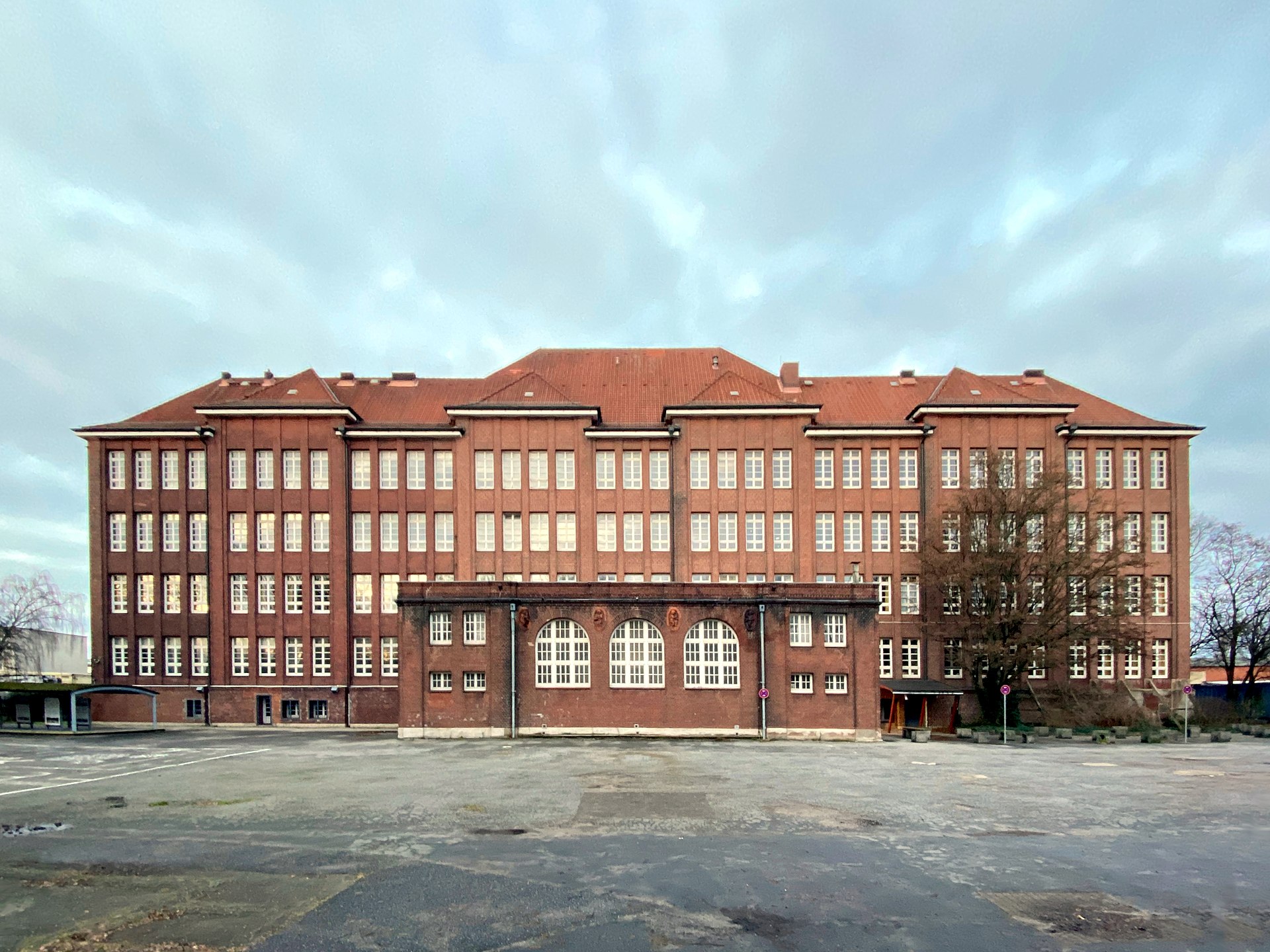
ブレンフューザー・ダム
Bullenhuser Damm
☆ ブレンフーザー・ダム学校は、ドイツのハンブルク、ローテンブルクゾルト地区のブレンフーザー・ダム92-94番地にある。ここは、第二次世界大戦末期の ホロコーストで、残虐な医学実験の被験者として使われた証拠を隠すために、20人の子供とその世話をする大人が殺害された「ブレンフーザー・ダム大虐殺」 の現場である。
| The Bullenhuser Damm School
is located at 92–94 Bullenhuser Damm in the Rothenburgsort section of
Hamburg, Germany – the site of the Bullenhuser Damm Massacre, the
murder of 20 children and their adult caretakers at the very end of
World War II's Holocaust – to hide evidence they were used as human
subjects in brutal medical experimentation.[1][2] During heavy air raids in the Second World War, many areas of Hamburg were destroyed, and the Rothenburgsort section was heavily damaged.[3] The school was only slightly damaged. By 1943, the surrounding area was largely obliterated so the building was no longer needed as a school. In October 1944,[4] a subcamp of the Neuengamme concentration camp was established in the school to house prisoners used in clearing the rubble after air raids. The Bullenhauser Damm School was evacuated on April 11, 1945. Two SS men were left to guard the school: SS Unterscharführer Johann Frahm and SS Oberscharführer Ewald Jauch, and the janitor Wilhelm Wede. On the night of April 20, 1945, 20 Jewish children, who had been used as human subjects in medical experiments at Neuengamme, along with their four adult caretakers and six Soviet prisoners, were injected with morphine and suspended from their necks to die on the basement walls of the school.[5] Later that evening, 24 Soviet prisoners were brought to the school to be murdered. The names, ages and countries of origin of the victims, who'd transited through the Neuengamme concentration camp, were recorded by Hans Meyer, one of the thousands of Scandinavian prisoners released to the custody of Sweden in the closing months of the war.[6] |
ブ
レンフーザー・ダム学校は、ドイツのハンブルク、ローテンブルクゾルト地区のブレンフーザー・ダム92-94番地にある。ここは、第二次世界大戦末期のホ
ロコーストで、残虐な医学実験の被験者として使われた証拠を隠すために、20人の子供とその世話をする大人が殺害された「ブレンフーザー・ダム大虐殺」の
現場である[1][2]。 第二次世界大戦の激しい空襲で、ハンブルクの多くの地域が破壊され、ローテンブルグゾート地区も大きな被害を受けた[3]。1943年までには、周辺地域 はほとんど消滅していたため、この建物は学校として必要ではなくなっていた。1944年10月、ノイエンガンメ強制収容所(Neuengamme concentration camp) のサブキャンプが、空襲後の瓦礫撤去に使用された囚人を収容するために、学校内に設置された[4]。ブレンハウザー・ダム学校は1945年4月11日に疎 開した。二人のSSが学校の警備に当たった: ヨハン・フラーム親衛隊上級大将とエバルト・ヤウフ親衛隊上級大将、そして用務員のヴィルヘルム・ヴェーデである。 1945年4月20日の夜、ノイエンガンメで人体実験に使われていた20人のユダヤ人の子供たちが、4人の大人の世話係と6人のソ連人囚人とともに、モル ヒネを注射され、首から吊るされて、学校の地下の壁の上で死んだ[5]。その日の夜遅く、24人のソ連人囚人が殺されるために学校に連れてこられた。 ノイエンガンメ強制収容所を通過した犠牲者の名前、年齢、出身国は、戦争末期にスウェーデンに解放された何千人ものスカンジナビア人捕虜の一人であるハンス・マイヤーによって記録された[6]。 |
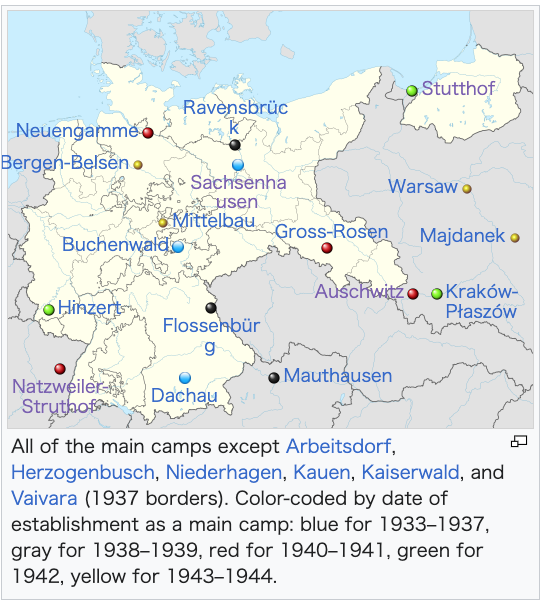 All of the main camps except Arbeitsdorf, Herzogenbusch, Niederhagen, Kauen, Kaiserwald, and Vaivara (1937 borders). Color-coded by date of establishment as a main camp: blue for 1933–1937, gray for 1938–1939, red for 1940–1941, green for 1942, yellow for 1943–1944. |
 Arbeitsdorf、Herzogenbusch、Niederhagen、Kauen、Kaiserwald、Vaivara(1937年の国境) を除くすべての主要収容所。1933-1937年を青、1938-1939年を灰色、1940-1941年を赤、1942年を緑、1943-1944年を 黄色。 |
| Neuengamme experimentation SS physician Kurt Heissmeyer, to achieve a credentialled professorship, needed to present original research. Although previously disproven, his hypothesis was that the injection of live tuberculosis bacilli into subjects would act as a vaccine. Another component of his experimentation was based on pseudoscientific Nazi racial theory that race played a factor in developing tuberculosis. He attempted to prove his hypothesis by injecting live tuberculosis bacilli into the lungs and bloodstream of Untermenschen (subhumans), Jews and Slavs being considered by the Nazis to be racially inferior to Germans. He was able to have the facilities made available and to test his subjects as a result of his personal connections: his uncle, SS general August Heissmeyer, and his close acquaintance, SS general Oswald Pohl.[7] The medical experiments on tuberculosis infection were initially carried out on prisoners from the Soviet Union and other countries at the Neuengamme concentration camp. The experiments were then extended to Jews. For this Heissmeyer chose to use Jewish children. Twenty Jewish children (10 boys and 10 girls) from Auschwitz concentration camp were chosen by Josef Mengele and sent to Neuengamme. Mengele allegedly asked the children, "Who wants to go and see their mother?" The children were accompanied to Neuengamme by four women prisoners. Two were Polish nurses and one was a Hungarian pharmacist, and they were killed upon arrival at Neuengamme. The fourth woman, Polish-born Jew Paula Trocki, was a doctor. She survived the war and later gave testimony in Jerusalem about what she had witnessed: The transport was accompanied by an SS guard. There were 20 children, one female medical doctor, three nurses. The transport was in a separate carriage that was coupled on a normal train. Presented in this manner it appeared to be an ordinary carriage. We had to take off the stars of David lest we attract any attention. To prevent people from approaching us they said it was a transport of people suffering from typhoid fever... The food was excellent; on that journey we were given chocolate and milk. After a two-day trip we arrived at Neuengamme at ten o'clock at night. — Paula Trocki[8] The children were injected with live tuberculosis bacilli, and they all became ill. Heissmeyer then had their axillary lymph nodes surgically removed from their armpits and sent to Hans Klein at the Hohenlychen Hospital for study. All the children were photographed holding up one arm to show the surgical incision. Klein was not prosecuted. The collapsing western front and imminent approach of British troops prompted the perpetrators to murder the subjects of the experiment to cover up their crimes. The orders for the murders were issued from Berlin.[citation needed] The children, their four adult caretakers and six Soviet prisoners were brought by truck to the Bullenhuser Damm School in the Hamburg suburb of Rothenburgsort. The school had been taken over by the SS to house prisoners from Neuengamme used to clear rubble from the surrounding area after Allied bombing raids. The SS evacuated the building around April 11, 1945, leaving a skeleton crew of two SS guards: Ewald Jauch and Johann Frahm and a janitor. They were accompanied by three SS guards (Wilhelm Dreimann, Adolf Speck, and Heinrich Wiehagen), as well as the driver, Hans Friedrich Petersen, and SS physician Alfred Trzebinski. The children as well as others were told they were being taken to Theresienstadt. Upon arriving at the school they were led into the basement. According to one of the SS men present, the children "sat down on the benches all around and were cheerful and happy that they had been for once allowed out of Neuengamme. The children were completely unsuspecting." They were then made to undress and were then injected with morphine by Trzebinski. They were then led into an adjacent room and hanged from hooks set into the wall. The execution was overseen by SS Obersturmführer Arnold Strippel. The first child to be hanged was so light that the noose would not tighten. Frahm grabbed him in a bearhug and used his own weight to pull down and tighten the noose. The adults were hanged from overhead pipes; they were made to stand on a box, which was pulled away from under them. That same night, about 30 additional Soviet prisoners were also brought by lorry to the school to be executed; six escaped, three were shot trying to do so, and the rest were hanged in the basement.[9] |
ノイエンガンメの実験 ナチス親衛隊の医師クルト・ハイスマイヤーは、教授資格を得るために独創的な研究を発表する必要があった。以前は否定されていたが、彼の仮説は、生きた結 核菌を被験者に注射すればワクチンとして機能するというものだった。彼の実験のもう一つの要素は、人種が結核発症の要因であるというナチスの偽科学的人種 論に基づいていた。 彼は、ナチスがドイツ人より人種的に劣っているとみなしたユダヤ人とスラブ人であるUntermenschen(亜人)の肺と血流に生きた結核菌を注射することで、自分の仮説を証明しようとした。 彼は、叔父である親衛隊大将アウグスト・ハイスマイヤーや親しい知人であった親衛隊大将オスヴァルト・ポールという個人的なコネクションの結果、施設を利用することができ、被験者を実験することができた[7]。 結核感染に関する医学実験は、当初ノイエンガンメ強制収容所でソ連やその他の国の囚人に対して行われた。その後、実験はユダヤ人にも拡大された。そのため にハイスマイヤーはユダヤ人の子供を使うことにした。アウシュヴィッツ強制収容所から20人のユダヤ人の子供たち(男子10人、女子10人)がヨーゼフ・ メンゲレによって選ばれ、ノイエンガンメに送られた。メンゲレは子供たちに、"誰が母親に会いに行きたいか?"と尋ねたと言われている。 ノイエンガンメには、4人の女性囚人が子供たちを連れて行った。二人はポーランド人の看護婦、一人はハンガリー人の薬剤師であったが、ノイエンガンメ到着 と同時に殺された。4人目の女性、ポーランド生まれのユダヤ人パウラ・トロッキは医者だった。彼女は戦争を生き延び、後にエルサレムで自分が目撃したこと について証言した: 輸送車にはSSの衛兵が同乗していました。20人の子供たち、1人の女医、3人の看護婦がいました。移送は、普通の列車に連結された別の車両で行われた。 こうして見ると、普通の客車に見えました。注目を浴びないように、ダビデの星を外さなければならなかった。人々が私たちに近づかないようにするため、腸チ フスにかかった人々の輸送だと言われた......。その旅ではチョコレートとミルクが配られた。日間の旅の後、私たちは夜の10時にノイエンガンメに到 着した。 - パウラ・トロッキ[8]。 子供たちは生きた結核菌を注射され、全員が発病した。ハイスマイヤーはその後、脇の下から腋窩リンパ節を手術で摘出し、研究のためにホーエンライヒェン病 院のハンス・クラインに送った。子供たちは全員、手術の切開部分がわかるように片腕を上げて写真に撮られた。クラインは起訴されなかった。 西側戦線が崩壊し、イギリス軍の接近が迫っていたため、犯人たちは自分たちの犯罪を隠蔽するために実験対象者を殺害した。殺人の命令はベルリンから出された。 子供たち、4人の大人の世話係、6人のソ連人捕虜は、トラックでハンブルク郊外のローテンブルクゾルトにあるブレンフーザー・ダム学校に運ばれた。この学 校は、連合軍の空襲の後、周辺地域の瓦礫撤去に使われたノイエンガンメの捕虜を収容するためにSSが引き継いだものだった。SSは1945年4月11日ご ろに建物を退去させ、2人のSS看守を残して、骨格を失った: エヴァルト・ヤウフとヨハン・フラーム、そして管理人である。彼らには3人のSS看守(ヴィルヘルム・ドライマン、アドルフ・スペック、ハインリヒ・ ヴィーハーゲン)、運転手のハンス・フリードリヒ・ペーターゼン、SS医師のアルフレッド・トルゼビンスキが同行した。子供たちだけでなく他の人々も、テ レジエンシュタットに連れて行かれると告げられた。学校に到着すると、彼らは地下室に案内された。その場にいたSS隊員の一人によると、子どもたちは「そ こらじゅうのベンチに座り、ノイエンガンメから一度だけ外に出られたことを明るく喜んでいた」。子供たちはまったく疑っていなかった」。 その後、子供たちは服を脱がされ、トルゼビンスキーにモルヒネを注射された。そして、隣の部屋に連れて行かれ、壁に仕掛けられたフックで首を吊った。処刑 はSS親衛隊上級大将アーノルド・シュトリッペルが監督した。最初に吊るされた子供はとても軽く、縄が締まらなかった。フラームは彼を抱きかかえ、自分の 体重を利用して縄を引き下げ、締めた。大人たちは頭上のパイプに吊るされ、箱の上に立たされた。同じ夜、さらに約30人のソ連人捕虜が処刑されるために ローリーで学校に運ばれた。 |
Victims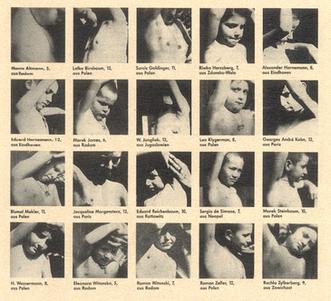 The children showing the location of the scar where the axillary lymph nodes were excised 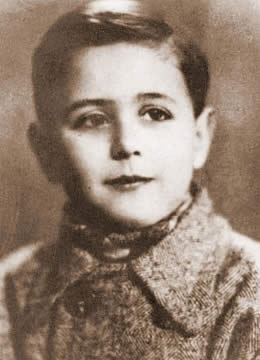 Sergio de Simone (b. Nov. 29, 1937 d. April 20, 1945), seven-year-old Jewish Italian boy killed at the Bullenhauser Damm School 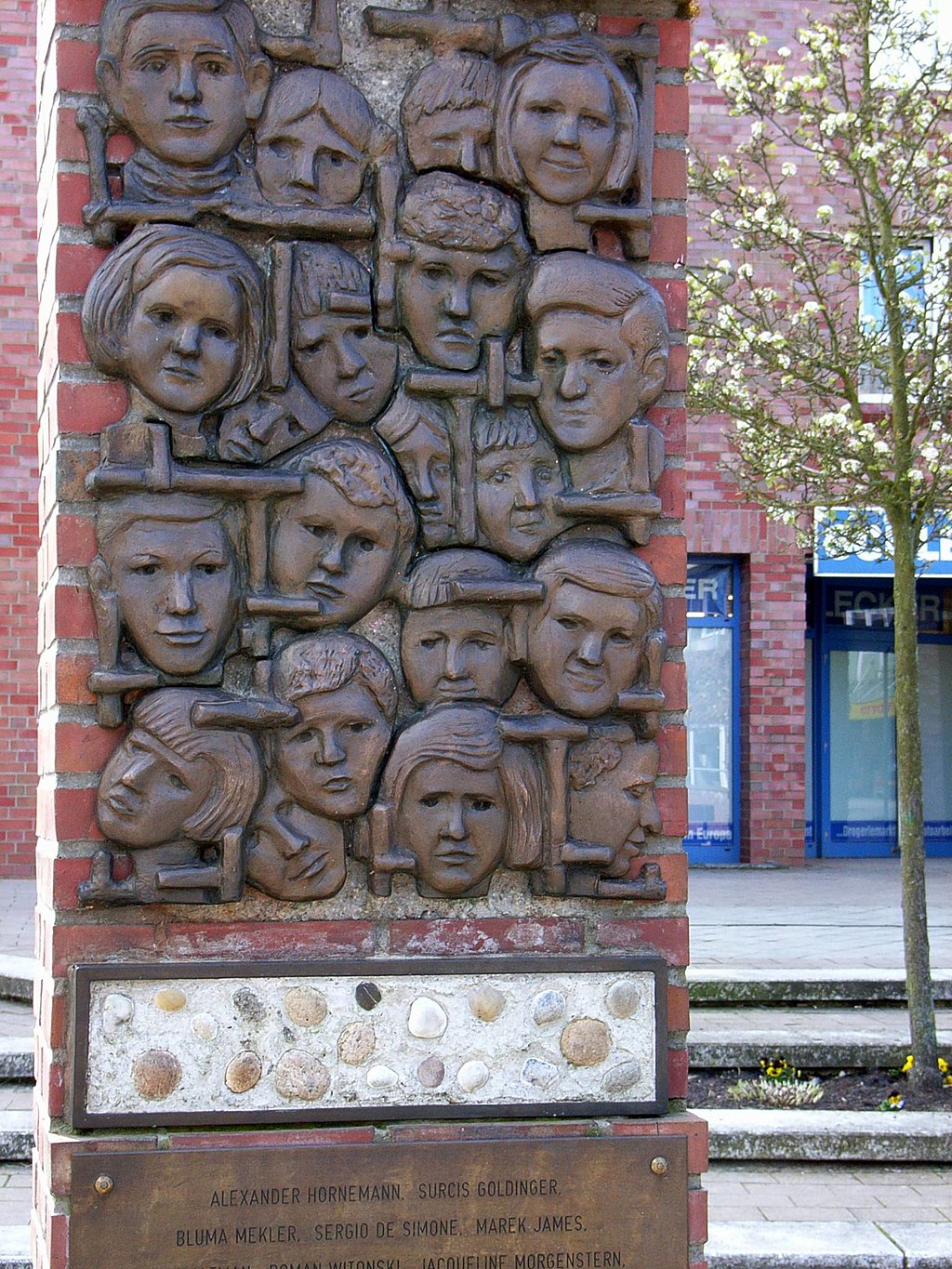 Bronze Relief Stele Commemorating the 20 Children of the Bullenhuser Damm Massacre Bronze relief stele, mounted on brick pilaster; below the relief: listing of the children's names; artist: Leonid Mogilevski (Russian, 1931-); bronze: 0,30m wide 0,60m high; placed July 13, 2001; initiative by and paid for by Hamburg citizens; marked with an annual commemoration on April 20.[10] Location: Roman-Zeller-Platz Hamburg-Schnelsen 53°38′48.9″N 9°54′37.3″E Marek James,[11] a boy aged 6, from Radom, Poland; prisoner no. B 1159. H. Wassermann,[12] a girl aged 8, from Poland. Commemorated with the Wassermann Park in Hamburg-Burgwedel, named after her. Roman Witonski,[13] a boy aged 6, and his sister; prisoner number A-15160. Eleonora Witonska,[14] a girl aged 5, from Radom, Poland; prisoner number A-15159. (Roman and Eleanora were deported to Auschwitz along with their mother, Rucza Witonska (prisoner number A-15158) from the ghetto in Radom, Poland. Their father, Seweryn Witonski, a pediatrician from Radom, was gunned down at an execution in the Szydlowiec cemetery. Ruzca worked in the laboratory of Josef Mengele. In November 1944, the children were separated from their mother when she was sent to the concentration camp in Gebhardsdorf in Lower Silesia. Roman and Eleonora were sent to the "Kinderheim" (orphanage) at Auschwitz. Rucza survived the war and tried to find her children. She later remarried. Rosa Grumelin has visited the memorial)[15] Roman Zeller, a boy aged 12, from Poland. Roman-Zeller-Platz, in Hamburg Schelsen is named after Roman Zeller. Riwka Herszberg, a girl aged 7, from Zdunska Wola, Poland. (Her parents were Mania and Moishe Herszberg. They were kept in the family barracks for a period of time. Her mother survived the war.) Mania Altmann, a girl aged 5, from Radom, Poland. Surcis Goldinger, a girl aged 11, from Poland. Lelka Birnbaum, a girl aged 12, from Poland. Ruchla Zylberberg, a girl aged 8, from Zawichost, Poland. (Ruchla's sister, Esther, and her mother, Fajga (née Rosenblum), were gassed upon arrival in Auschwitz. Her father, Nison Zylberberg, survived the war in the Soviet Union, with his brother, Henry, and his sister, Felicja; he then emigrated to the United States. He died in Colorado on September 29, 2002, at the age of 86. He visited the memorial.)[16] Eduard Reichenbaum, a boy aged 10, from Katowice, Poland. (His brother Itzhak survived the war and emigrated to Haifa, Israel.) Blumel Mekler, a girl aged 11, from Sandomierz, Poland. (Her sister, Shifra, survived the war because, as she recalled, her mother told her to "run! Shifra! run!" as the round-up began. She was 8 at this time, and Blumel was 5. She was kept hidden by a Polish family. She emigrated to Tel Aviv, Israel, and married. She has visited the memorial.) Eduard (Edo) Hornemann, a boy aged 12. (Born on January 1, 1933), he lived with his mother, Elisabeth, his father, Philip, and his brother, Alexander, at 29 Staringstraat in Eindhoven, the Netherlands. His parents worked at the Philips factory. Philip died on February 21, 1945, at Sachsenhausen, where he arrived after a stop at Dachau with the "death march". Elisabeth died of typhus in Auschwitz in October 1944. Alexander Hornemann, a boy aged 9. (b. May 31, 1936.) Georges André Kohn, a boy aged 12, from Paris, France. (b. April 23, 1932.) Jacqueline Morgenstern, a girl aged 12, from Paris. (b. May 26, 1932. A cousin, Henry Morgenstern, survived the war and has visited the memorial.) Sergio De Simone, a boy aged 7, from Naples, Italy; prisoner no. 179694. (b. November 29, 1937). Son of Italian Eduardo de Simone and his Russian Jewish wife Gisella (née Perlow). Arrested March 21, 1944, in Fiume. First sent to San Sabba then on March 29, 1944, to Auschwitz. His mother survived the war and has visited the memorial. Marek Steinbaum, a boy aged 10, from Radom, Poland. (His sister, Lola, survived the war and emigrated to the US, living in San Francisco; she has visited the memorial.) Walter Jungleib,[17] a boy aged 12, from Slovakia. As researched by Bella Reichenbaum (Haifa), the Neuengamme Concentration Camp Memorial received a letter from Israel in July 2015 noting that the name Jungleib had been recorded on a list of a prisoner transport from Auschwitz to Lippstadt; contact was made with this family near Tel Aviv via the website of the Yad Vashem Memorial; there the 85-year-old Grete Hamburg, born in Hlohovec / Slovakia confirmed that it was her brother: Walter Jacob Jungleib.[18] Lea Klygermann, a girl aged 12, from Poland; prisoner no. A 16959. The children were in the care of four male prisoners, a French doctor and a chemist and two Dutch prisoners, all of whom had been imprisoned because of their anti-German activities. The French doctor and the chemist were: René Quenouille (born December 6, 1887, in Lyon).[19] He was a physician and radiologist at a hospital in Villeneuve-Saint-Georges, near Paris and a member of the French Resistance. He was arrested by the Gestapo, together with his wife, Yvonne, on March 3, 1943. Yvonne was released after three and a half months, but he was sentenced to death, although the sentence was later commuted to imprisonment. Professor Gabriel Florence (born June 12, 1884). He was a chemist[20] who taught at the University of Lyon. He fought in World War I and joined the French Resistance during World War II. He was arrested by the Gestapo on March 4, 1944. The two Dutch prisoners were: Anton Holzel (born May 7, 1909), who came from Deventer. He was a driver and a member of the Dutch Communist Party, who joined the Resistance after the German invasion. He became a waiter at the Novotel Den Haag, a hotel in The Hague, to facilitate the transfer of messages. He was arrested on September 11, 1941, and sent to Buchenwald. He was later transferred to Neuengamme.[21] Dirk Deutekom (born December 12, 1895), who was a typographer. A member of the Dutch Resistance, he tried to hinder the deportation of Dutch Jews from the Netherlands. He was arrested in July 1941 and sent to Buchenwald, where he was given a job in the infirmary, owing to his fluency in German. On June 6, 1944, he was transferred to the concentration camp at Neuengamme. |
被害者 腋窩リンパ節を切除した傷跡の位置を示す子供たち  セルジオ・デ・シモーネ(1937年11月29日生まれ、1945年4月20日没)、ブレンハウザー・ダム学校で殺された7歳のユダヤ系イタリア人の少年  ブロンズ・レリーフ ブレンハウザー・ダム大虐殺の20人の子供たちを記念するブロンズ・レリーフ碑、レンガのピラスターに取り付けられ、レリーフの下には子供たちの名前のリ ストがある: 作者:レオニード・モギレフスキー(ロシア、1931年~)、ブロンズ:幅0.30m、高さ0.60m、2001年7月13日設置、ハンブルク市民が発起 人となり費用を負担、毎年4月20日に記念式典が行われる[10]: ローマン・ツェラー・プラッツ ハンブルグ・シュネルセン 53°38′48.9″N 9°54′37.3″E マレク・ジェイムズ[11]、ポーランドのラドム出身の6歳の少年。B 1159. H. ワッセルマン、[12] ポーランド出身の8歳の少女。ハンブルク=ブルクヴェーデルのワッセルマン公園は彼女の名にちなんで命名された。 ロマン・ヴィトンスキ、[13] 6歳の少年とその妹、囚人番号A-15160。 エレオノラ・ヴィトンスカ[14]、5歳の少女、ポーランドのラドム出身、囚人番号A-15159。(ロマンとエレオノーラは、母親のルツァ・ウィトンス カ(囚人番号A-15158)とともに、ポーランドのラドムのゲットーからアウシュヴィッツに強制送還された。ラドムの小児科医であった父親セヴェリン・ ヴィトンスキは、シドロヴィエツ墓地での処刑で銃殺された。ルツカはヨーゼフ・メンゲレの研究所で働いていた。1944年11月、母親がニーダーシレジア のゲバールスドルフの強制収容所に送られ、子供たちは母親と引き離された。ロマンとエレオノーラはアウシュビッツの「キンダーハイム」(孤児院)に送られ た。ルツァは戦争を生き延び、子供たちを探そうとした。彼女は後に再婚した。ローザ・グルメリンは記念館を訪れている)[15]。 ロマン・ツェラー、ポーランド出身の12歳の少年。ハンブルク・シェルゼンのローマン・ツェラー広場はローマン・ツェラーにちなんで名づけられた。 リウカ・ヘルツベルク、7歳の少女、ポーランドのズドゥンスカ・ヴォラ出身。(両親はマニアとモイシェ・ヘルツベルグ。両親は一時期バラックに収容された。母親は戦争を生き延びた)。 マニア・アルトマン、5歳の少女、ポーランドのラドム出身。 スルシス・ゴルディンガー、11歳の少女、ポーランド出身。 レルカ・ビルンバウム、12歳の少女、ポーランド出身。 ルクラ・ジルベルグ、8歳の少女、ポーランドのザヴィチョスト出身。(ルクラの姉エステル、母ファジャ(旧姓ローゼンブルム)はアウシュビッツ到着時にガ ス処刑された。彼女の父ニソン・ジルベルクは、兄ヘンリー、妹フェリチャとともにソ連で戦争を生き延び、その後アメリカに移住した。2002年9月29 日、コロラド州で86歳で死去。記念館を訪れた)[16]。 エドゥアルド・ライヘンバウム、ポーランドのカトヴィツェ出身の10歳の少年。(兄のイツァークは戦争を生き延び、イスラエルのハイファに移住した)。 ブルメル・メクレール、11歳の少女、ポーランドのサンミエシュ出身。(妹のシフラが戦争を生き延びたのは、彼女が回想するように、母親が「逃げなさい! シフラ!逃げなさい!」と母親に言われたからだ。彼女はポーランドの家族にかくまわれた。彼女はイスラエルのテルアビブに移住し、結婚した。彼女は慰霊碑 を訪れたことがある) エドゥアルト(エド)・ホルネマン、12歳の少年(1933年1月1日生まれ)。オランダ、アイントホーフェンのStaringstraat 29番地で、母エリザベート、父フィリップ、兄アレクサンダーと暮らす。両親はフィリップスの工場で働いていた。フィリップは1945年2月21日、「死 の行進」でダッハウに立ち寄った後、到着したザクセンハウゼンで死亡した。エリザベートは1944年10月にアウシュビッツでチフスで死亡。 アレクサンダー・ホルネマン、9歳の少年(1936年5月31日生まれ)。 ジョルジュ・アンドレ・コーン、12歳の少年、フランスのパリ出身。(1932年4月23日生まれ) ジャクリーヌ・モルゲンシュテルン、12歳、パリ出身。(1932年5月26日生まれ。従兄弟のヘンリー・モルゲンシュテルンは戦争を生き延び、慰霊碑を訪れている) セルジオ・デ・シモーネ、7歳の少年、イタリアのナポリ出身。179694. (1937年11月29日生まれ)。イタリア人エドゥアルド・デ・シモーネとロシア系ユダヤ人の妻ギセラ(旧姓パーロー)の息子。1944年3月21日、 フィウメで逮捕。最初にサン・サッバに送られ、1944年3月29日にアウシュビッツに送られた。母親は戦争を生き延び、慰霊碑を訪れている。 マレク・スタインバウム、10歳の少年、ポーランドのラドム出身。(妹のローラは戦争を生き延び、アメリカに移住してサンフランシスコに住んでいる。) ウォルター・ジャングリブ[17]、スロバキア出身の12歳の少年。ベラ・ライヘンバウム(ハイファ)が調査したように、ノイエンガンメ強制収容所記念館 は2015年7月にイスラエルから手紙を受け取り、アウシュヴィッツからリップシュタットへの囚人移送リストにジャングリブという名前が記録されているこ とを指摘した: ヴァルター・ヤコブ・ヤングリブ[18]。 レア・クライゲルマン、12歳の少女、ポーランド出身。A 16959. 子供たちは4人の男性囚人、フランス人医師と化学者、2人のオランダ人囚人に保護されていた。 フランス人医師と化学者は以下の通り: ルネ・クヌイユ(1887年12月6日、リヨン生まれ)[19]は、パリ近郊のヴィルヌーヴ・サン・ジョルジュにある病院の医師兼放射線科医で、フランス 人レジスタンスのメンバーであった。1943年3月3日、妻のイヴォンヌとともにゲシュタポに逮捕される。イヴォンヌは3ヵ月半後に釈放されたが、彼は死 刑判決を受けた。 ガブリエル・フローレンス教授(1884年6月12日生まれ)。リヨン大学で教鞭をとった化学者[20]。第一次世界大戦を戦い、第二次世界大戦中はフランスのレジスタンスに参加。1944年3月4日、ゲシュタポに逮捕される。 人のオランダ人捕虜がいた: アントン・ホルツェル(1909年5月7日生まれ)はデヴェンター出身。運転手でオランダ共産党員だったが、ドイツ侵攻後にレジスタンスに参加。ハーグの ホテル、ノボテル・デン・ハーグのウェイターとなり、メッセージの伝達を円滑にした。1941年9月11日に逮捕され、ブッヘンヴァルトに送られた。後に ノイエンガンメに移送された[21]。 Dirk Deutekom(1895年12月12日生まれ)タイポグラファー。オランダのレジスタンスのメンバーで、オランダからのオランダ系ユダヤ人の強制送還 を妨げようとした。1941年7月に逮捕され、ブッヘンヴァルトに送られたが、ドイツ語が堪能だったため、医務室で仕事を与えられた。1944年6月6 日、ノイエンガンメの強制収容所に移送された。 |
Criminal prosecutions "Place of children from Bullenhuser Damm" in Hamburg, Germany  Memorial for the Russian prisoners Some of those involved in the killings were tried by a British military court in Hamburg in 1946. Trzebinski, Neuengamme commandant Max Pauly, Dreimann, Speck, Jauch and Frahm were convicted and sentenced to death. They were all hanged at Hamelin Prison on October 8, 1946. Two of those directly responsible for the children's suffering and murder, Kurt Heissmeyer and Arnold Strippel, escaped and remained at large. Strippel had served at other concentration camps before Neuengamme, including Buchenwald. He was recognized on the street in Frankfurt in 1948 by a former Buchenwald prisoner. He was tried for the murders of 21 Jewish inmates committed on November 9, 1939, as retribution for the failed assassination of Adolf Hitler at the Bürgerbräukeller in Munich by Georg Elser. Strippel was tried, convicted of 21 counts of murder, and sentenced to 21 life terms by a Frankfurt court in 1949.[22] In 1964, an investigation into his involvement with the Bullenhuser Damm School murders was begun by the Hamburg prosecutor's office. The statute of limitations had run out for manslaughter, so he had to be charged with murder. Among the criteria for murder, it had to be proven that the accused acted cruelly, insidiously or with motive. In 1967 the prosecutor, Helmut Münzberg, dropped the charges for lack of evidence, stating that Strippel had not acted cruelly as "the children had not been harmed beyond the extinction of their lives". In 1969, Strippel was released from prison after his other convictions were reduced to being an accessory to murder. After his release, he applied for a retrial, and in 1970 his original conviction was overturned and he was retried. At this retrial, he was convicted as being just an accessory to the Buchenwald murders and sentenced to six years' imprisonment. Because he had already served 20 years in prison, 14 years longer than this sentence, he was compensated with 121,477.92 Deutschmarks. In 1979, partly as a result of articles written by Günther Schwarberg, Strippel's case was reopened. He was not reincarcerated, and in 1987 the case was abandoned by the Hamburg prosecutor's office, owing to Strippel's frailty.[23] Strippel died on May 1, 1994. Kurt Heissmeyer returned to his home in Magdeburg in postwar East Germany and started a successful medical practice as a lung and tuberculosis specialist. He was eventually found out in 1959. In 1966, he was convicted and sentenced to life imprisonment. At his trial he stated, "I did not think that inmates of a camp had full value as human beings." When asked why he did not use guinea pigs he responded, "For me there was no basic difference between human beings and guinea pigs." He then corrected himself: "Jews and guinea pigs".[24] Heissmeyer died in prison on August 29, 1967. |
刑事訴追 「ドイツ、ハンブルクの「ブレンフーザー・ダムの子供たちの場所  ロシア人捕虜の慰霊碑 1946年、ハンブルクの英国軍事法廷で、殺害に関与した者たちが裁かれた。トルゼビンスキー、ノイエンガンメ司令官マックス・ポーリー、ドライマン、ス ペック、ヤウフ、フラームが有罪判決を受け、死刑を宣告された。彼らは全員、1946年10月8日にハーメリン刑務所で絞首刑に処された。 子供たちを苦しめ、殺害した直接の責任者の二人、クルト・ハイスマイヤーとアーノルド・シュトリッペルは逃亡し、逃亡したままであった。シュトリッペルは ノイエンガンメ以前にも、ブッヘンヴァルトを含む他の強制収容所に勤務していた。彼は1948年、フランクフルトの路上で、ブッヘンヴァルトの元収容者に 認められた。彼は、1939年11月9日、ゲオルク・エルザーによるミュンヘンのビュルガーブロイケラーでのアドルフ・ヒトラー暗殺失敗の報復として、 21人のユダヤ人収容者を殺害した罪で裁判にかけられた。シュトリッペルは裁判にかけられ、21件の殺人罪で有罪判決を受け、1949年にフランクフルト の裁判所から21回の終身刑を言い渡された[22]。1964年、ハンブルク検察局によってブレンフーザー・ダム学校殺人事件への関与についての捜査が開 始された。過失致死罪の時効が切れたため、彼は殺人罪で起訴されることになった。殺人罪の基準の中には、被告人が残酷に、陰湿に、あるいは動機を持って行 動したことが証明されなければならなかった。1967年、検察官のヘルムート・ミュンツベルクは、「子供たちは命を失うほどの被害を受けていない」とし て、シュトリッペルは残虐な行為をしていないとし、証拠不十分で起訴を取り下げた。1969年、シュトリッペルは他の前科が殺人の従犯に減刑され、釈放さ れた。釈放後、彼は再審を申請し、1970年に元の有罪判決が覆され、再審となった。この再審で、彼はブッヘンヴァルト殺人事件の従犯として有罪判決を受 け、6年の禁固刑を言い渡された。彼はすでに20年服役しており、この刑期より14年も長かったため、12万1477.92ドイツマルクが補償された。 1979年、ギュンター・シュヴァールベルクが書いた記事の影響もあって、シュトリッペルの事件は再審された。シュトリッペルは再収監されず、1987 年、ハンブルク検察はシュトリッペルの虚弱を理由にこの事件を放棄した[23]。 クルト・ハイスマイヤーは戦後東ドイツのマクデブルクの自宅に戻り、肺と結核の専門医として診療を始め、成功を収めた。やがて1959年に発覚。1966 年、彼は有罪判決を受け、終身刑を言い渡された。裁判で彼は、"収容所の被収容者が人間として十分な価値があるとは思わなかった "と述べた。なぜモルモットを使わなかったのかという質問に対して、彼は "私にとって人間とモルモットの間に基本的な違いはなかった "と答えた。そしてこう訂正した: 「24]ハイスマイヤーは1967年8月29日に獄中で死去した。 |
Memorial Memorial in Schnelsen The building at Bullenhuser Damm was used by the British as a transit camp for German POWs until 1947. It was then used by the Hydrograpichal Institute's meteorological service until 1949, when it again became a school, for 800 boys. In 1959, the organization representing Neuengamme survivors proposed to the Hamburg school board that a memorial plaque should be placed in the school. However, it was not until 1963 that the text for the plaque was approved. The text aroused controversy because it omitted mention of the Soviet victims and did not state that the children were Jewish or give any information about their personal identity. In 1980, information signs were placed in the basement of the school, and the Senate of Hamburg (government) declared the school to be a memorial site, renaming it Janusz Korczak School: Korczak was a Polish-Jewish pediatrician and author who was murdered at Treblinka extermination camp with about 190 orphans. A rose garden was established in 1985. Later, in the Schnelsen Quarter of the city several streets were named after the children who died at the school and a memorial tablet was installed. Much of the work of identifying the victims and of bringing the story to the public's attention was due to the efforts of Günther Schwarberg.[25] In 2005, Wolfgang Peiner, Minister of Finance of Hamburg, published plans to sell the building. However, after several protests a spokesman denied these plans. In 2011 a new exhibition (telling the story in German and English) was opened at the Memorial.[26] |
記念碑 シュネルゼンのメモリアル ブレンフーザー・ダムにある建物は、1947年まで英国がドイツ兵捕虜の移送収容所として使用していた。その後、1949年まで水力学研究所の気象学サー ビスによって使用され、その後再び800人の少年たちのための学校となった。1959年、ノイエンガンメの生存者を代表する団体がハンブルクの教育委員会 に、学校に記念プレートを設置するよう提案した。しかし、プレートの文面が承認されたのは1963年のことであった。その文章は、ソ連の犠牲者についての 言及を省き、子供たちがユダヤ人であったことも、彼らの個人的な身元についての情報も述べていなかったため、論争を巻き起こした。1980年、学校の地下 に案内板が設置され、ハンブルク元老院(政府)は学校を追悼施設と宣言し、ヤヌシュ・コルチャック学校と改名した: コルチャックはポーランド系ユダヤ人の小児科医で作家、約190人の孤児とともにトレブリンカ絶滅収容所で殺害された。1985年にバラ園が作られた。そ の後、同市のシュネルセン地区には、この学校で亡くなった子供たちの名前を冠した通りが数本作られ、記念碑が設置された。犠牲者を特定し、この事件を世に 知らしめた多くの仕事は、ギュンター・シュヴァールベルクの努力によるものだった[25]。 2005年、ハンブルク財務大臣ヴォルフガング・パイナーは、この建物を売却する計画を発表した。しかし、何度かの抗議の後、スポークスマンはこの計画を否定した。 2011年、記念館に新しい展示(ドイツ語と英語でストーリーを語る)がオープンした[26]。 |
| https://en.wikipedia.org/wiki/Bullenhuser_Damm |
|
リ ンク
文 献
そ の他の情報
Copyleft, CC, Mitzub'ixi Quq Chi'j, 1996-2099
☆
 ☆
☆